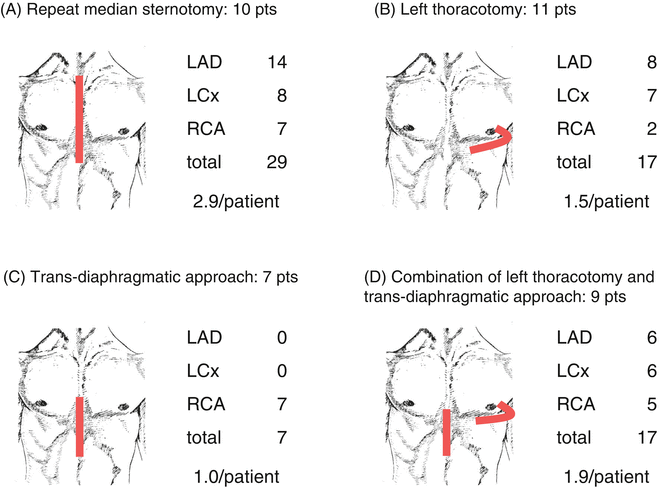Characteristics
Value
Male/female
24/13
Mean age (years)
71.6 ± 8.1
Diabetes mellitus
22 (59 %)
Dyslipidemia
23 (62 %)
Hypertension
34 (92 %)
Smoking
20 (54 %)
Cerebrovascular accident
5 (14 %)
Renal dysfunction
5 (14 %)
Low ejection fraction
5 (14 %)
Prior myocardial infarction
23 (62 %)
Previous PCI
15 (41 %)
Preoperative use of IABP
5 (14 %)
Emergent/urgent operation
4 (11 %)
Presence of a patent graft
25 (68 %)
Presence of a patent ITA-LAD graft
16 (43 %)
Table 21.2
Graft selection in primary CABG and redo CABG
LITA | RITA | GEA | RA | SV | IEA | |
|---|---|---|---|---|---|---|
Previous CABG | 25 | 4 | 1 | 3 | 41 | – |
Patent | (16) | (3) | (0) | (1) | (8) | – |
Stenosis | (2) | (0) | (0) | (0) | (3) | – |
Occlusion | (7) | (1) | (1) | (2) | (30) | – |
Redo CABG | 9 | 8 | 20 | 16 | 12 | 1 |
The approaches used to access the target coronary arteries were (1) repeat median sternotomy in ten (27 %) patients, (2) left thoracotomy in 11 (30 %) patients, (3) the transdiaphragmatic approach in seven (19 %) patients, and (4) combination of the left thoracotomy and transdiaphragmatic approach in nine (24 %) patients (Table 21.3). The relationship of each approach and target vessels is described in Fig. 21.1. Left thoracotomy was used for revascularization of the left coronary artery and distal branches of the RCA, and the transdiaphragmatic approach was used for revascularization of the RCA. Target vessels in all territories could be revascularized by combination of the left thoracotomy and transdiaphragmatic approach. Twenty-seven patients (73 %) avoided repeat median sternotomy in redo OPCAB. In 25 patients who had at least one patent graft, 22 patients (88 %) avoided resternotomy. The mean number of distal anastomoses at redo operation was 1.9 ± 1.1 (1–5), and grafts used at redo operation were LITA in nine patients, RITA in eight patients, GEA in 20 patients, RA in 16 patients, SV in 12 patients, and IEA in one patient (Table 21.2). Total arterial revascularization was completed in 25 patients (68 %). The number of distal anastomoses in each territory was 28 in LAD, 21 in LCx, and 21 in RCA. The relationship of target vessels and inflow sources is listed in Table 21.4. The GEA, LSCA, and descending thoracic aorta played an important role as inflow sources for revascularization to the LCx and RCA in redo OPCAB via an alternative approach. Complete revascularization was achieved in 27 patients (73 %), and when combined with staged PCI, complete revascularization was achieved in 29 patients (78 %). In a later period (when off-pump procedure was applied in all elective primary cases after 2002), complete revascularization was achieved in 23 of 26 patients (88 %).

Table 21.3
Approach to the heart in reoperative patients
Approach | Value |
|---|---|
Repeat median sternotomy | 10 (27 %) |
Avoiding repeat median sternotomy | 27 (73 %) |
Left thoracotomy | 11 (30 %) |
Transdiaphragmatic approach | 7 (19 %) |
Combination of left thoracotomy and transdiaphragmatic approach | 9 (24 %) |

Fig. 21.1
The relationship of each approach and target vessels is described. (b) Left thoracotomy is used for revascularization of the LCA and distal branches of the RCA, and (c) transdiaphragmatic approach is used for revascularization of the RCA. Target vessels in all territories are revascularized by (d) combination of left thoracotomy and transdiaphragmatic approach. The mean number of distal anastomoses is 2.9 in (a) repeat median sternotomy, 1.5 in (b) left thoracotomy, 1.0 in (c) transdiaphragmatic approach, and 1.9 in (d) combination of left thoracotomy and transdiaphragmatic approach. LCA left coronary artery, RCA right coronary artery, LAD left anterior descending artery, LCx left circumflex artery
Table 21.4
The relationship of target vessels and inflow sources
Inflow source | LAD (28) | LCx (21) | RCA (21) |
|---|---|---|---|
LITA | 9 | 2 | 1 |
RITA | 7 | 0 | 2 |
GEA | 5 | 5 | 14 |
AsAo | 4 | 6 | 1 |
LSCA | 2 | 5 | 2 |
DsAo | 1 | 3 | 1 |
One patient (3 %; age, 85 years) died due to sepsis. Injury of the right ventricle requiring repair was observed in one patient (3 %) who needed conversion to CPB support without cardioplegic arrest. No perioperative myocardial infarction occurred, and only one patient (3 %) needed prolonged ventilation (>48 h) postoperatively. Twenty patients (54 %) underwent postoperative angiography, and all grafts were found to be patent.
In our experience, an off-pump procedure in redo CABG can be performed with a low perioperative morbidity and mortality and satisfactory graft patency. An alternative approach to avoid repeat median sternotomy is a promising option for selected patients who have patent grafts and higher risk profiles for resternotomy or CPB.
References
1.
Lytle BW, Loop FD, Cosgrove DM, Taylor PC, Goormastic M, Peper W, Gill CC, Golding LA, Stewart RW (1987) Fifteen hundred coronary reoperations: results and determinants of early and late survival. J Thorac Cardiovasc Surg 93:847–859PubMed
2.
3.
4.
5.
6.
7.
Lytle BW, McElroy D, McCarthy P, Loop FD, Taylor PC, Goormastic M, Stewart RW, Cosgrove DM (1994) Influence of arterial coronary bypass grafts on the mortality in coronary reoperations. J Thorac Cardiovasc Surg 107:675–683PubMed
8.
9.
10.
11.
12.
Elami A, Laks H, Merin G (1994) Technique for reoperative median sternotomy in the presence of a patent left internal mammary artery graft. J Card Surg 9:123–127CrossRefPubMed
Stay updated, free articles. Join our Telegram channel

Full access? Get Clinical Tree


